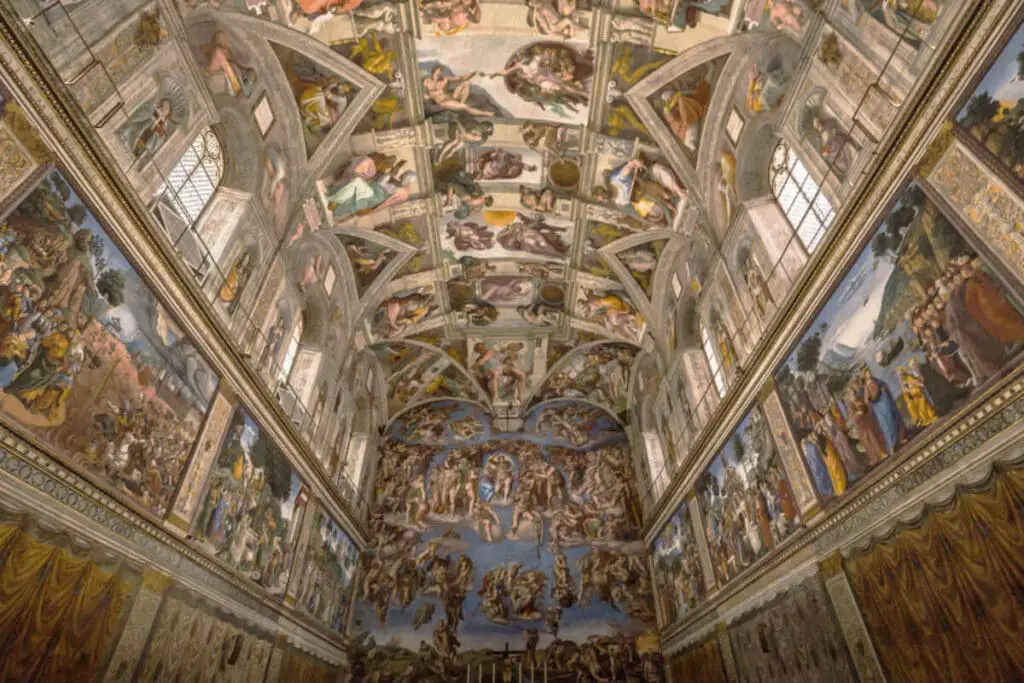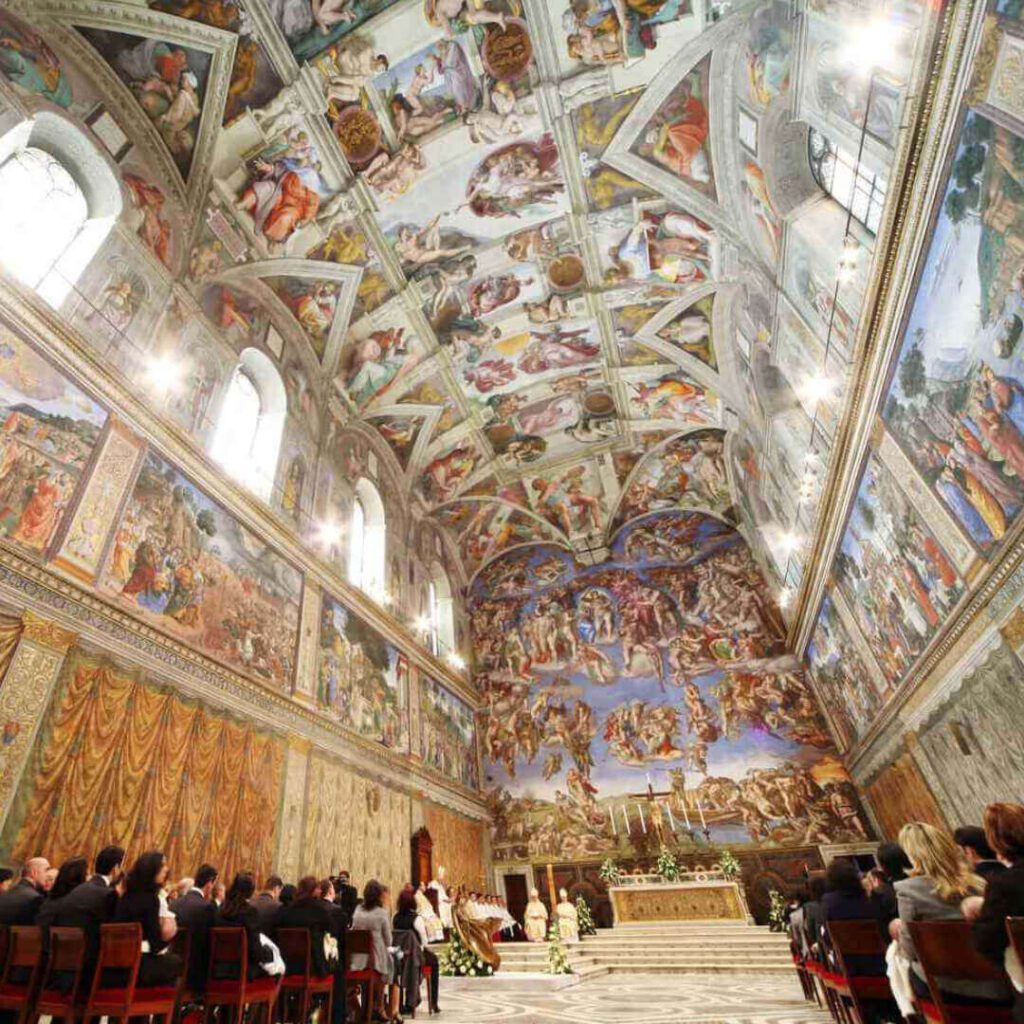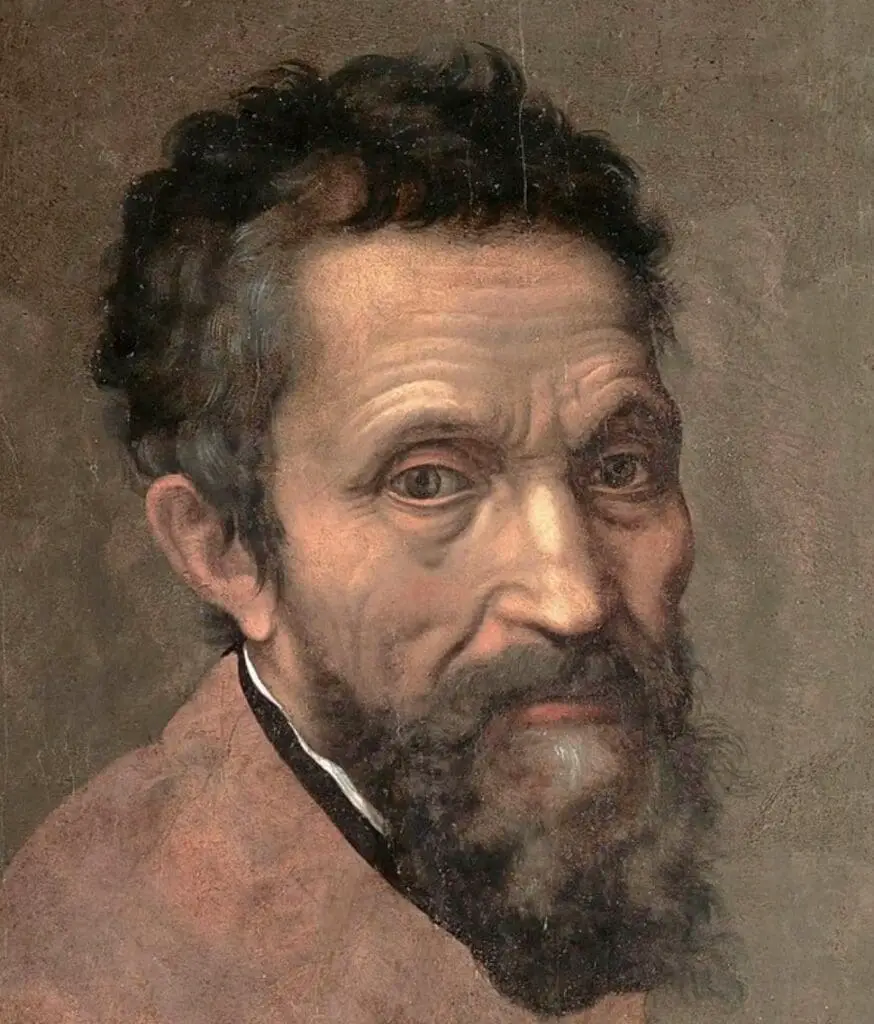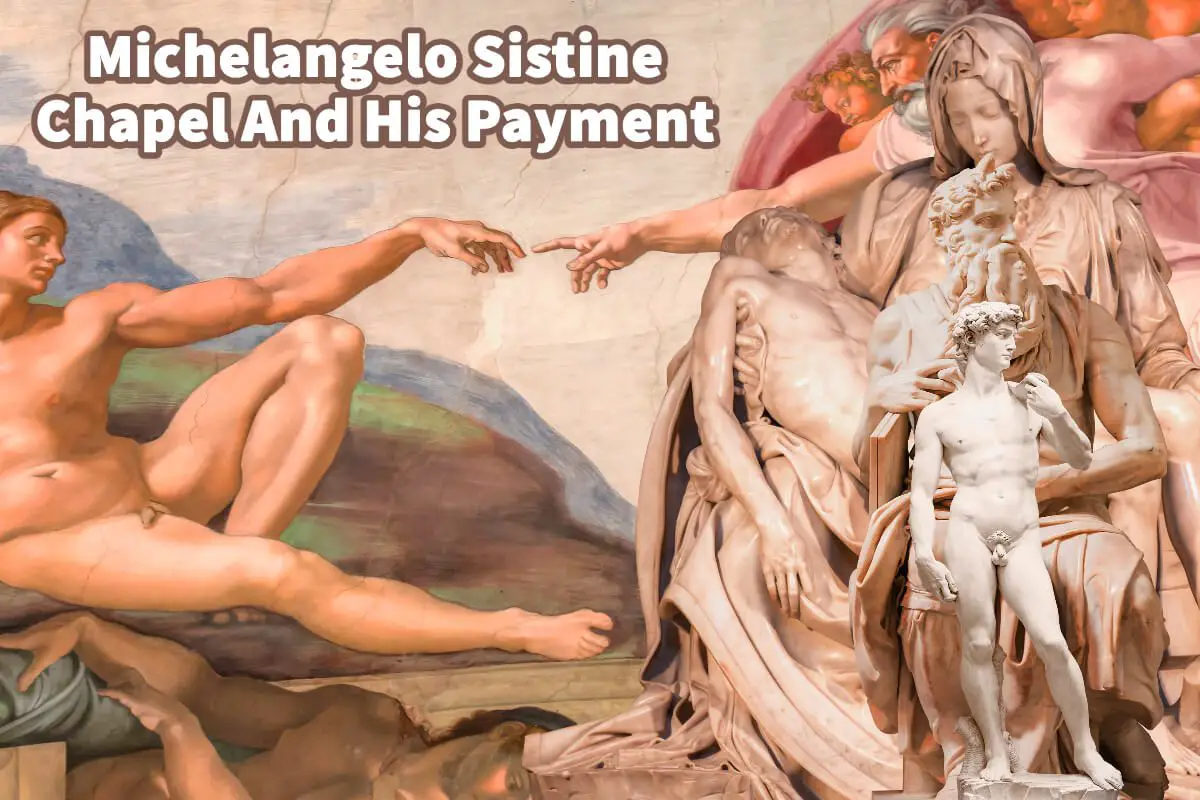Michelangelo was a master artist during the Renaissance era. Many people also see him as one of the great artistic masters who did not receive all that was due to him for the payment for his work.
Michelangelo was paid 3200 gold ducats for his work on the ceiling of the Sistine Chapel, which would have been a very lucrative commission. We know that he stopped work on the ceiling for a while due to his not being paid by the Vatican. Michelangelo liked to give the impression that he was a penniless artist, but records show that he died an extremely wealthy man.
Table of Contents
- Michelangelo’s Sistine Chapel Payment
- Michelangelo’s Sistine Chapel Payment Dispute
- Michelangelo And His Extreme Wealth
- Frequently Asked Questions
- Related Questions
Michelangelo’s Sistine Chapel Payment
Michelangelo was paid about 3200 gold ducats to work on the ceiling of the Sistine Chapel, which would have worked out to about 750 ducats per year. For this time, this was quite a large sum of money.
Michelangelo was given about 400 ducats for his work on the David statue and 450 ducats for the Pieta statue. By the time he was commissioned to paint the Sistine Chapel, he was a well-known artist, and his artistic rate had increased significantly.

Michelangelo’s Sistine Chapel Payment Dispute
The commission for the Sistine Chapel ceiling was a vast and very lucrative commission for Michelangelo. No one can doubt that it was challenging work.
From about September 1510 until about mid-1511 or longer, Michelangelo refused to do any work on the Sistine Chapel ceiling painting. He was disputing the payment for the work he had completed so far.
In August 1510, the Pope left Rome to go to the Papal States and conquer Bologna, and it was not in Rome. Michelangelo was not being paid regularly for his work in the Sistine Chapel.
We know that Michelangelo had stopped working on the ceiling by September of that same year to protest his not getting paid regularly for his work. Michelangelo was distraught by this, so he went twice to see the Pope during his travels to try to settle this payment matter.
But it was not until the Pope returned to Rome that Michelangelo was paid for his work, and then Michelangelo began again to complete the work of the Sistine Chapel. The fact that Michelangelo would stop the work for payment with the Pope as the art patron shows us a lot about the personality of this elusive man.

Listen To Our Podcast About Michelangelo’s Hidden Wealth below or by clicking here.
Michelangelo And His Extreme Wealth
Michelangelo passed himself off as a poverty-stricken artist, but the truth is that when he died, he was an extremely wealthy man. During his lifetime Michelangelo complained that he was living in poverty, but the truth is far from that, and records show he was not only extremely wealthy but also a miser.

Rab Hatfield, a professor at the Florence branch of Syracuse University, said this about Michelangelo and his wealth when speaking to the Los Angeles Times:
“He was a funny sort of man, somewhat paranoid and somewhat dishonest, who didn’t want it to be known he was fabulously rich.”
Rab Hatfield
Hatfield has been able to find some of Michelangelo’s old bank accounts and deeds of purchase that show a very different kind of story. When he died in 1564, it is estimated that his net worth was at least 50,000 gold ducats which would have been more than money than many princes and dukes had at that time.
This amount of money would have made Michelangelo an extremely wealthy man. When Michelangelo died, there were 8,400 ducats found in a wooden box next to his bed.
To put that money in perspective, the Pitti Palace, which is now a giant art gallery in central Florence, was sold to a Duchess for 9,000 gold ducats. We can say that Michelangelo had money in a box near his bed that would have allowed him to purchase a palace in Florence.

A lot of Michelangelo’s money was in real estate. He had a farm near Rome that produced a nice income for him and some houses in Rome and Florence, but he still died with a large sum of cash in a box near his bed.
Michelangelo liked to pass himself off to the Popes and art patrons that he was a starving artist and did not have a lot of money. He seems to have played the role of poverty exceedingly well, with many art patrons believing him and paying him well even for work he never completed.
In speaking of Michelangelo and his fantastic wealth, Rab Hatfield said this to the Los Angeles Times:
“Michelangelo tried to give the impression that his patrons, especially the popes, had treated him unfairly, when the reverse was true. They paid him extremely good money, but he bit off more than he could chew and sometimes didn’t deliver.”
Rab Hatfield
An example is that Pope Julius II gave Michelangelo a huge advanced payment for the 40 life-size statues he wanted for his tomb. Michelangelo had other commissions that kept him busy, but he gladly took the money and never delivered all 40 statues.
In fact, Michelangelo only completed three of the statues. One of the statues of a seated Moses is considered one of his masterpieces.
There is no doubt that Michelangelo was an extremely gifted artist, one of the most proficient in the High Renaissance era. He has many works of art that are still considered masterpieces today.
On a personal level, he seems to have been quite the character. In fact, so many people saw Michelangelo as cash-strapped and a starving artist that was just not true; he died an extremely wealthy man.
Frequently Asked Questions
Why did Michelangelo decide to work on the ceiling of the Sistine Chapel, and how did he come to be commissioned for this project?
Michelangelo was commissioned to paint the ceiling of the Sistine Chapel by Pope Julius II in 1508. The pope admired Michelangelo’s artistic talent and wanted to showcase the grandeur of the Vatican through this masterpiece.
How much was Michelangelo paid for his work on the Sistine Chapel, and was it considered a substantial amount during the Renaissance era?
Michelangelo received 3200 gold ducats for his work on the Sistine Chapel ceiling. This was a considerable sum during the Renaissance, reflecting the prestige and importance of the commission.
Why did Michelangelo stop working on the Sistine Chapel ceiling, and how did payment issues play a role in this interruption?
Michelangelo faced payment delays from the Vatican, leading him to temporarily halt work on the Sistine Chapel ceiling. The financial disputes with the papal treasury were a significant factor in this interruption.
Were there specific reasons for the payment delays Michelangelo experienced during the Sistine Chapel project?
Payment delays were often attributed to financial constraints within the Vatican. The papal funds were allocated to various projects and endeavors, causing delays in payments to artists like Michelangelo.
How did Michelangelo portray his financial situation during his lifetime, and what do historical records reveal about his actual wealth at the time of his death?
Despite giving the impression of being a struggling artist, Michelangelo amassed considerable wealth during his lifetime. Historical records show that he died as an extremely wealthy man, challenging the popular perception of the penniless artist.
Did Michelangelo face any consequences or disputes with the Vatican due to his decision to temporarily stop work on the Sistine Chapel ceiling?
While there were tensions and disputes over payment, Michelangelo’s stature as an esteemed artist protected him from severe consequences. The papacy recognized the importance of completing the masterpiece and eventually resolved the payment issues.
Were there alternative payment methods or arrangements considered between Michelangelo and the Vatican for the Sistine Chapel project?
Records indicate that Michelangelo was initially promised a different form of compensation for his work, but he ultimately received a monetary payment of 3200 gold ducats. The negotiations and arrangements between the artist and the Vatican were complex.
How did Michelangelo’s financial success impact the perception of artists during the Renaissance era?
Michelangelo’s financial success challenged the prevailing notion of artists as struggling and impoverished. His wealth contributed to changing perceptions about the value of artistic endeavors and the potential for financial prosperity in the field.
Did Michelangelo’s payment for the Sistine Chapel ceiling contribute to his overall wealth, or were there other significant sources of income for the artist?
While the payment for the Sistine Chapel project was substantial, Michelangelo had various sources of income, including commissions, investments, and business ventures. His financial success was multifaceted.
How did Michelangelo’s experience with payment for the Sistine Chapel project influence the compensation and treatment of artists in subsequent periods?
Michelangelo’s experience highlighted the challenges artists faced in securing fair compensation for their work. This historical episode likely contributed to discussions about the fair treatment and payment of artists in subsequent artistic endeavors and commissions.
Anita Louise Art is dedicated to art education, great artists, and inspiring others to find and create their art. We love art that uplifts and inspires. #ArtToMakeYouSmile! #ArtToMakeYouHappy!
If you are interested in seeing any of my art, you can find out more by clicking here. If you are interested in what inspires me and my paintings, you can discover more by clicking here.
We have a free newsletter and would love you to be part of our community; you can subscribe to the newsletter by clicking here. If you have any questions, I would be happy to talk to you. You can reach me, Anita, by clicking here.
Subscribe to our Anita Louise Art YouTube Channel filled with great videos and information by clicking here.
Join us for our podcast “5 Minutes With Art.” Spend just 5 minutes a week with us to discover and learn about great art and artists. You can find out more about our podcast by clicking here.
Related Questions
Did Michelangelo And Leonardo Know Each Other?
Michelangelo and Leonardo da Vinci knew each other but were considered bitter rivals. Leonardo da Vinci and Michelangelo knew each other, but they did like each other. They were both asked to do a commission on the Council Hall of the Palazzo Vecchio and were supposed to work side-by-side; the project was never completed.
By clicking here, you can learn more by reading Did Michelangelo And Leonardo Know Each Other?.
What Was The Focus Of Renaissance Art?
The focus of Renaissance art was on the classics of Greek and Rome, humanist philosophy, and the study of the human figure. Realism was also an essential part of renaissance art. The great artists of the Renaissance also became great anatomists and studied human beings.
By clicking here, you can learn more by reading What Was The Focus Of Renaissance Art?.
Michelangelo’s Method To Paint The Sistine Chapel Ceiling
He built a large scaffolding structure that could move around the chapel to paint the ceiling; the painting of the Sistine Chapel was an extremely strenuous work that was a huge personal cost both physically and mentally to Michelangelo.
By clicking here, you can learn more by reading Michelangelo’s Method To Paint The Sistine Chapel Ceiling.

